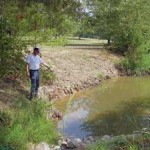At a recent conference/expo I asked all of the reserve study companies if they had begun to include the things that are not obvious, in their studies. Most said ‘no’, but they would try to help an association if they were asked. By “not obvious”, I mean those items that are underground, or inside of walls. Now the first thing that often comes to mind is that most of these items have life expectancies of more than 50 years, but guess what, there are a lot of associations that are past their 50th anniversary.
Here are the problems you’re dealing with:
- First, you probably don’t have a clue as to where the piping (water, sewer, drain lines), or the electrical and communication cables, are actually located. If you’re lucky, you have the “as-built” drawings that may, I said “may”, come close to where these items are actually located.
- Second, you probably don’t know what materials they are made of, so a guess at life expectancy is probably just that, a guess.
- Third, but probably the most problematic, is you don’t really know if they were built to code when they were installed, or if there are new code requirements that will require significant investment when the time comes to repair or replace them. I mention this because a report I saw on the news yesterday claimed that code inspectors are the most bribed individuals in local government.
 Last – I’ve really started to see a lot of news stories about items that are common elements, but which the association wasn’t even clear on owning it. This has been especially noticeable with retention ponds and dams. Too many association believed that they were the responsibility of the local government or ignored them when it came to budgeting reserve funds for them. Sadly, the cost of replacing a dam was too much for some associations and their lake disappeared with the removal of the dam.
Last – I’ve really started to see a lot of news stories about items that are common elements, but which the association wasn’t even clear on owning it. This has been especially noticeable with retention ponds and dams. Too many association believed that they were the responsibility of the local government or ignored them when it came to budgeting reserve funds for them. Sadly, the cost of replacing a dam was too much for some associations and their lake disappeared with the removal of the dam.
Why worry about these items?
- Condo’s with single water meters and multiple buildings or underground connections, could spring a leak, after the meter, but underground. You may not notice it until the next water bill arrives, or the ground starts to give way and you end up with a sinkhole.
- The same holds true for sewer and drain lines, which often dump large amounts of waste before a leak is even noticed.
- Repair and replacement costs for these items is significant. First you have to find them, then determine what is to be done, followed by a lot of digging with ugly mounds of dirt, asphalt and concrete sitting around, not mention the inconvenience to the owners when their water supply is shut off.
So what do you do if you’re around that 50 year mark.
- First, see if you have accurate site plans that show where these things are. Dig a few test holes to see if the lines are where the plans show them.
- Talk to your reserve professionals about what they can do to help. It might require an engineering firm to do some sampling, but when you look at the linear footage of what may need to be replaced, and the estimated cost for that, getting an expert involved early in the process may be worth it. In some cases, miniature cameras can be inserted into pipes to check how they are holding up from the inside.
- Communicate with the owners about what you are doing and why. The point is to prevent special assessments for something that you’ve known is there, but haven’t paid much attention to because of it’s life expectancy.
 The very first condo management job I had was as a resident manager in a converted apartment complex. The as-built plans didn’t exist and during my time there we discovered a whole raft of code problems and just plain stupidity, such as the water pipes running through the ceilings of the lower units were a combination of galvanized steel and copper, without the required coupling. As a result, 6 months after I started we had 15 major water leaks in a very short period, before we could initiate a system-wide repair process. A lot of damage, a lot of angry owners and a lot of sleepless nights for me. The point is that the water lines were hidden and no one knew the materials or that the needed coupling was not used.
The very first condo management job I had was as a resident manager in a converted apartment complex. The as-built plans didn’t exist and during my time there we discovered a whole raft of code problems and just plain stupidity, such as the water pipes running through the ceilings of the lower units were a combination of galvanized steel and copper, without the required coupling. As a result, 6 months after I started we had 15 major water leaks in a very short period, before we could initiate a system-wide repair process. A lot of damage, a lot of angry owners and a lot of sleepless nights for me. The point is that the water lines were hidden and no one knew the materials or that the needed coupling was not used.
What do you really know about your infrastructure???????

